The AMD Trinity Review (A10-4600M): A New Hope
by Jarred Walton on May 15, 2012 12:00 AM ESTAMD Trinity Gaming Performance
After the 3DMark results, you might be wondering if Intel has finally caught up to AMD in terms of integrated graphics performance. The answer is…yes and no. Depending on the game, there are times where a fast Ivy Bridge CPU with HD 4000 will actually beat out Trinity; there are also times where Intel’s IGP really struggles to keep pace. The good news is that at least everyone is now onboard the DX11 bandwagon, and compatibility with games has improved yet again for Intel. Here are our “Value” benchmark results for seven recent games; we’ll have more information in a moment.

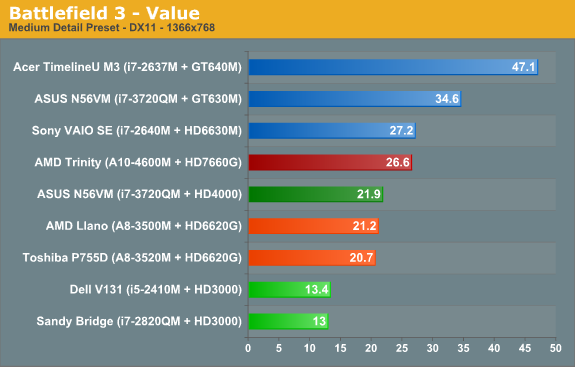
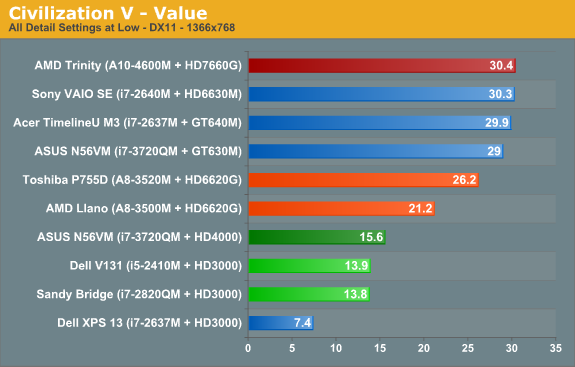

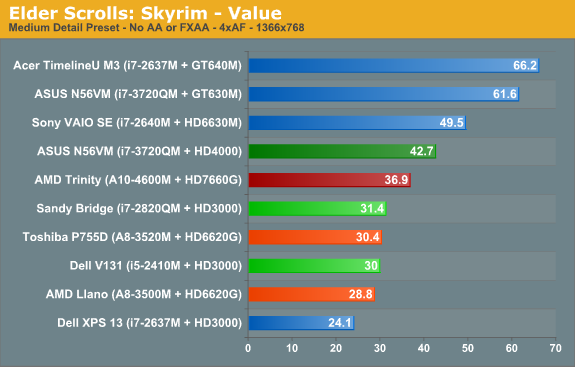
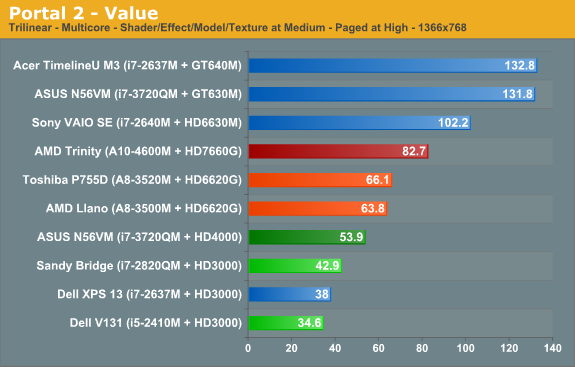
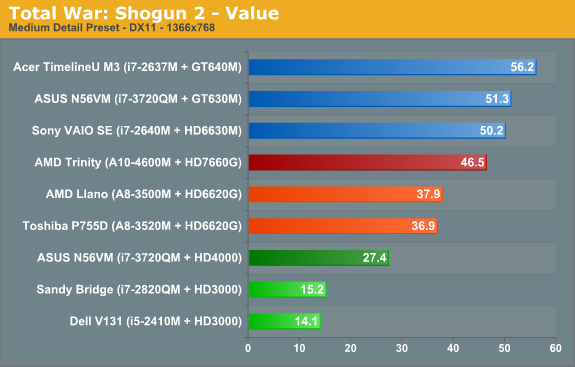
Out of our seven test titles, AMD’s Trinity leads any other IGP in four titles by a large margin. The other three titles actually have Ivy Bridge slightly ahead of Trinity, but the gaps aren’t nearly as big. Overall, the average performance across the seven games at our Value (medium) settings has AMD’s Trinity A10-4600M leading Intel’s i7-3720QM by 21%, and if we look at quad-core Sandy Bridge with HD 3000 (i7-2820QM) Trinity is 72% faster. Trinity is also around 20% faster than 35W Llano on average.
Let’s expand our gaming suite just a bit to see if things change, though. Just like we did with Ivy Bridge, we ran the eight games in our previous benchmark suite at medium detail settings. We can then compare performance across a wider 15 title selection to see how Trinity matches up against HD 4000, HD 3000, and HD 6620G (Llano). We’ll start with the bottom (HD 3000/Sandy Bridge) and move up.
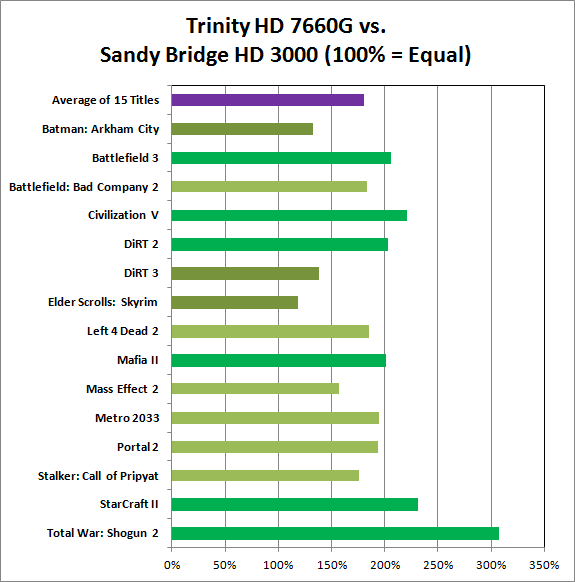
Llano’s HD 6620G was already faster than HD 3000, and Trinity’s HD 7660G is faster than Llano, so the Sandy Bridge gaming matchup is a landslide victory in AMD’s favor. The closest Intel can get is in the same three titles where Ivy Bridge leads Trinity: Batman: Arkham City, DiRT 3, and Skyrim. Here, however, HD 3000 can’t actually close the gap and HD 6620G is at least 20% faster than HD 3000, with an average performance improvement of nearly 80%.
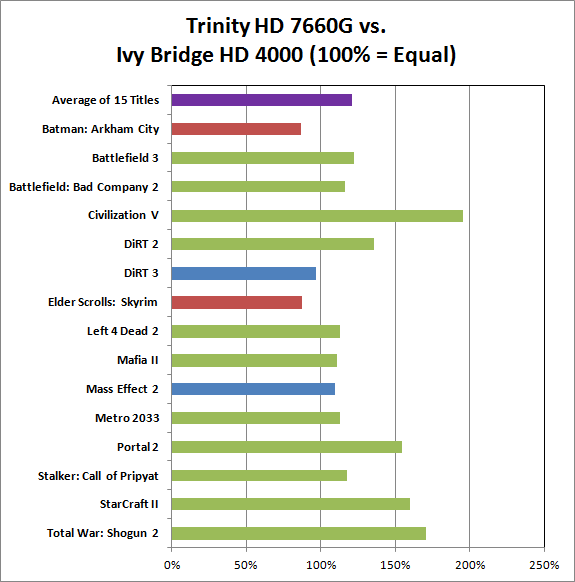
We found that across the same selection of 15 titles, Ivy Bridge and Llano actually ended up “tied”—Intel led in some games, AMD in others, but on average the two IGPs offered similar performance. This chart and the next chart will thus show a similar average increase in performance for Trinity, but the details in specific games are going to be different. Starting with Ivy Bridge and HD 4000, as with our earlier game charts we see there are some titles where Intel leads (Batman and Skyrim), a couple ties (DiRT 3 and Mass Effect 2), and the remainder of the games are faster on Trinity. Mafia II is close to our <10% “tie” range but comes in just above that mark, as do Left 4 Dead 2 and Metro 2033. The biggest gap is Civilization V, where Intel’s various IGPs have never managed good performance; Trinity is nearly twice as fast as Ivy Bridge in that title. Overall, it's a 20% lead for Trinity vs. quad-core Ivy Bridge.
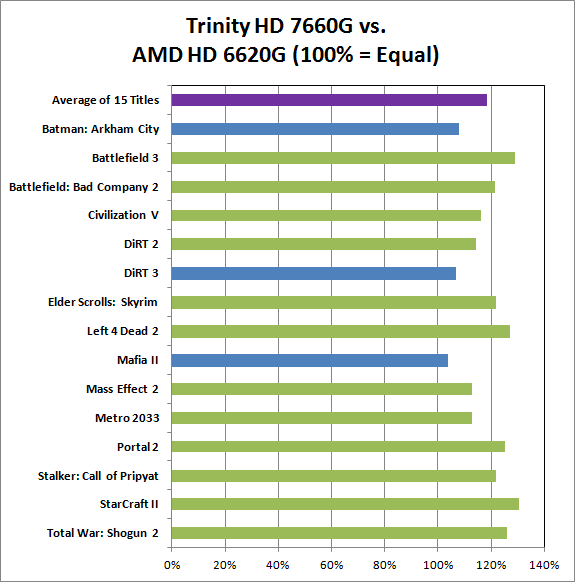
Against Llano, Trinity is universally faster, but the smallest gap is in Mafia II (3%) while the largest gap is in StarCraft II (30%). On average, looking at these games Trinity is only 18% faster than Llano. What’s not entirely clear from the above chart is whether we’re hitting CPU limitations, memory bandwidth limitations (remember that Llano and Trinity share bandwidth with the rest of the system), or perhaps both. At our chosen settings, what is clear is that Trinity’s “up to 56% faster” graphics never make it that high.
We saw 35-45% higher scores in 3DMark 11 and Vantage, which tend to remove the CPU from the equation more than actual games, so our guess would be that if AMD continues with their APU plan they’re going to need to work more on the CPU side of the equation. We also see the same thing looking at the VAIO SE scores in the earlier gaming charts: the HD 6630M scores are 20% faster on average, but much of that appears to come from the faster CPU rather than the GPU.










271 Comments
View All Comments
Wierdo - Tuesday, May 15, 2012 - link
I'll start recommending an integrated Intel GPU once I feel more confident about their driver support, which is more important than performance.At least now the IGP in Ivy Bridge is a decent solution for basic gaming needs, but they really need to work on their drivers, no more of that "driver update five years after product is obsolete" bs.
Spunjji - Wednesday, May 16, 2012 - link
I agree, although even that seems to have improved somewhat; at least from the base standard of "what works to begin with". Here's hoping for further progress.medi01 - Wednesday, May 16, 2012 - link
Except there is one thing which isn't visible on charts: quality. Check how horrible Intel's AF is on toms Trinity review.fumigator - Tuesday, May 15, 2012 - link
"AMD still has better drivers than Intel, but it's more like 20% better "Unluckly I had an Ivy Bridge HD4000 notebook sitting for a week, and out of 29 games, only 60% were barely playable (performance), 15% crashed, and the rest run with strange artifacts but stable enough though.
While I don't worry alot about gaming in a laptop, the true fact is that intel is way behind AMD in this, and we are not talking about 3D render quality. Oh my, you have to take a look at that and you won't doubt it a second. AMD and Nvidia renders are better.
While I still hoped more from trinity, not sure to make a judgement until I grab one and put a decent super fast ram module on it and go testing.
JarredWalton - Tuesday, May 15, 2012 - link
Could you please provide a list of the games that were unplayable and those that crashed? I'd love to be able to confirm problems.frozentundra123456 - Tuesday, May 15, 2012 - link
The gpu is "several orders of magnitude" better than intel's best? You do realize that an order of magnitude is 10x right? So how many orders of magnitude better 2, 3, 4 (100x, 1000x, 10000x). Overstate much?In fact trinity is on average what, 20-30% better than HD4000? Hardly one order of magnitude much less multiple orders of magnitude.
Overall the chip is OK, but I was actually hoping for more improvement on the GPU side. Yes, it is improved, but not enough to really make a game go from unplayable to playable.
BSMonitor - Tuesday, May 15, 2012 - link
Most laptops from that time did not use Intel's IGP on the chipset. Most had AMD or nVidia dGPU's. And these new Trinity APU's probably compete pretty closely to that.RussianSensation - Tuesday, May 15, 2012 - link
Core 2 Duo came out in 2006 not 2004.Intel doesn't sell Core 2 Duo laptops anymore in mainstream segments. They sell IVB laptops.
Are you implying that C2D user will want to upgrade to Trinity?
Most users would be far better off getting an Intel laptop with low end Kepler GPU such as GT640 than this.
Lugaidster - Tuesday, May 15, 2012 - link
Assuming equal pricing sure. But there's no way an IVB with a low end Kepler will be near a trinity laptop in terms of pricing. Most likely it will be a few hundred dollars more, which depending on the target, can make a difference.Sure you can recommend that, but not everyone will see that as worth the extra couple of hundred dollars. Considering that aside from CPU performance, a trinity notebook is roughly equal to an IVB one, with price in their favour, they can sell lots of these.
JarredWalton - Tuesday, May 15, 2012 - link
I expect we'll see dual-core IVB with Kepler going for around $800-$850 at the low end of the scale. I also expect we'll see a lot of the early Trinity laptops with A10-4600M selling for closer to $700. Hopefully I'm wrong on the Trinity side, but they did the same thing with Llano. "It's new! Charge more for it!" Not AMD's fault at all, obviously, but still irritating.